Cross Oak is a small hamlet situated in the county of Breconshire, just north of the larger settlement of Talybont-on-Usk. Nearby are the villages of Llanfeugan, Llandetty and Llansantffraed. Situated in a small memorial garden in Cross Oak is a war memorial, in the form of a Celtic Cross, which was originally erected to commemorate the men of Llanfeugan who fell during the Great War. Originally the memorial bore five names on its front face. Memorial plaques were also erected in the nearby Churches of Llandetty and Llansantffraed, but in the 1980’s the names of the men on these memorials were added to the left-hand face of the Cross Oak war memorial. This page of the website commemorates all of these men and is split into the two sections as per the memorial.
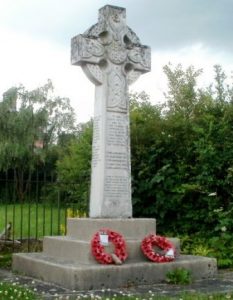
The Great War, 1914-1918 (Cross Oak/ Llanfeugan)
William Davies, Lance Corporal, 37119, Royal Welsh Fusiliers. William was the son of David and Elizabeth Ann Davies, of Gilestone Cottage, Talybont-On-Usk, Breconshire. He had served as a Policeman at Brecon and Brynmawr prior to the war and enlisted at Brecon into the Royal Welsh Fusiliers. He was posted to France early in 1916, joining the 2nd Battalion, Royal Welsh Fusiliers, which was attached to 19 Brigade, 33rd Division. During the evening of 21 June 1916, the 2nd RWF moved into trenches at Givenchy. At around 01.40 on the morning of 22 June 1916, a terrific explosion brought terror to the men posted in the trenches. The Germans had blown a mine beneath the line held by B Company of the 2nd RWF, engulfing two-thirds of its men in tons of earth and debris. William was one of many men killed during the explosion, both above and below ground. He was 25 years old and is commemorated on the Loos Memorial, France, as his body was never recovered. The crater was later named the Red Dragon Crater, in honour of the 2nd RWF who defended the position against the resulting German attack.
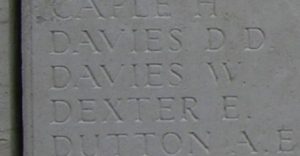
John Evans, Private, 20333, South Wales Borderers. John was born in 1896, the son of Benjamin Evans and Annie Sophia Evans (nee Jones), of Nant y Llanerch, Llanfeugan. The family had moved to 13, Greenfield Road, Mountain Ash by 1901, where Benjamin had found work as coalminer. John’s mother, Annie, died in 1911 and the family moved again, to 11, Alexandra Terrace, Mountain Ash, whilst some of John’s siblings moved back to their grandparents at Aber, Talybont-on-Usk. John enlisted at Ebbw Vale into the 10th Battalion, South Wales Borderers soon after the outbreak of war. The battalion was at Colwyn Bay attached to the 43rd (Welsh) Division. The Division trained in North Wales before moving to Winchester in the summer of 1915, where the formation became renumbered 115 Brigade, 38th (Welsh) Division. The Division began moving to France on 2 December 1915 and moved to the Nursery Sector near Fleurbaix for trench initiation alongside the Guards Division. The Division then held a sector of the line near Cuinchy before marching south to the Somme sector in June 1916 to take part in the assault on Mametz Wood. The first attack on the wood was launched on a two-battalion front on 7 July, but failed, and the Divisional Commander, Sir Ivor Philipps, was replaced before the Division attacked again on a two Brigade front on 10 July 1916. John was killed in action during that first day of the battle. The 20-year-old has no known grave and is commemorated on the Thiepval Memorial, France.
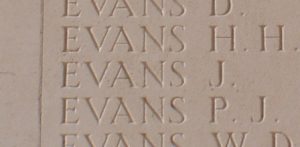
William Herring, Private, 126149, Machine Gun Corps. William was born in 1897, the son of Richard Herring and Ann Herring (nee Price), of Cross Oak, Talybont-on-Usk. He enlisted at Brecon into the army and was originally posted to the 4th (Reserve) Battalion, Welsh Regiment for training. William was drafted to France in the spring of 1918, and was posted to the 74th Battalion, Machine Gun Corps, which was attached to the 74th (Yeomanry) Division. The Division had spent much of the war fighting in Palestine, but as a result of the heavy losses suffered in France, following the launching of the three German Spring offensives from 21 March 1918, was sent to France, landing in Marseilles on 7 May 1918. The Division underwent a system of training, to prepare it for the vastly different conditions on the Western Front, before taking over a section of the front in the St. Floris Sector. On 25 July the division moved into reserve positions here for the first time. At the end of August, the Division moved south to the Somme sector, to join the great offensive, and on 18 September took part in an assault on positions near Lempire and Ronssoy, which formed part of the outer defensive line for the Hindenburg Line. After suffering heavy casualties, especially around Orchard Post and Gillemont Farm, the Division then attacked the Quadrilateral defences, suffering heavily again before being relieved on 24 September and entrained at Péronne for northern France once more. The Division then took part in the Advance in Flanders, and by the end of October had reached Marquion, launching an assault from there on 2 November, before establishing a new front line. By now William had taken ill and he was evacuated from the front to the base hospital at Wimereux. He died there of pneumonia on 4 November 1918. The 21-year-old was buried in Terlincthun British Cemetery, Wimille, France.
John Samuel Jones, Rifleman, S/6192, Rifle Brigade. John was born in 1896, the son of Charles Jones and Jennett Jones, of Cross Oak, Talybont. He was working as a coalminer in Seven Sisters when war broke out and enlisted at Neath into the Rifle Brigade. John was drafted to France on 29 July 1915 and joined the 1st Battalion, Rifle Brigade, which was at Ypres, attached to 11 Brigade, 4th Division. The division was holding the Canal Bank sector at Boesinghe, north of Ypres, when John arrived and was rebuilding following heavy losses suffered during the Second Battle of Ypres. The division then transferred to the Somme sector and took up positions in the Hamel Sector, where it remained during the coming months. The Allies were preparing to launch a great offensive on the Somme that summer, which eventually opened at 06.20 on 1 July 1916, with the blowing of a series of vast underground mines. The 4th Division assaulted the German lines near Puisieux on that first day, suffering heavy casualties before its assaulting battalions were relieved and moved to billets in Mailly-Maillet. The battered division saw further fighting on the Somme over the coming weeks before being relieved and moved north to Esquelbecq by 23 July, prior to moving back into the Canal Bank sector at Ypres to rebuild. At the beginning of September, the division was again relieved and began to move back south to re-join the Somme offensive and moved to positions near Flers. On 18 October 1916 John’s battalion attacked the German line at Lesboeufs, but suffered terrible casualties, with over 260 officers and men killed, wounded or missing. John was posted among the missing that day but was later found to have been taken prisoner by the Germans. He was transported back to a prisoner of war camp in Cologne. Unfortunately, John’s health broke down in the squalid conditions in the camp and he died there of tuberculosis on 20 May 1917. The 21-year-old was buried in Cologne Southern Cemetery, Germany.
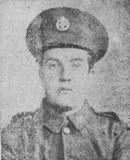
William Pitt, Corporal, 23300, South Wales Borderers. William was born at Brilley, Herefordshire in about 1877, the son of Henry Pitt and Esther Pitt (nee Lewis). By 1901 he was residing at Forest Road Hay, where he had found work as a labourer. William was residing at Cross Oak, Talybont when war broke out and he enlisted at Brecon into the South Wales Borderers on 8 February 1915. William was then posted to the 12th Battalion, South Wales Borderers. The battalion was raised at Newport by the Welsh National Executive Committee in March 1915 as a bantam Battalion, then in July 1915 moved to Prees Heath to join the Welsh Bantam Brigade. During September 1915 the Brigade moved to Aldershot and became 119 Brigade, in the 40th (Bantam) Division. In December 1915 the Division moved to Blackdown to complete its training before embarking for France and landing at Le Havre on 2 June 1916. The Division moved to positions around Lillers before taking over the North Maroc Sector, near Loos, for trench initiation and once acclimatised was left to hold the sector itself over the coming months. The infantry battalions of the Division then began the usual routines of rotating for duty in the trenches: normally four days in the front line; four in support and four in reserve. Late in 1916 the Division moved south to the Somme, and fought at the Battle of the Ancre, before remaining in the sector over the winter. William struggled with his health during that cold winter and was found to be suffering from arthritis. His ability was so impaired by his condition that he was discharged from the army as medically unfit on 24 July 1917 and returned home to Cross Oak. He died on 3 May 1919, aged 42. Nothing further is currently known of William, as he is not commemorated by the CWGC.
The Great War, 1914-1918 Llandetty and Llansantffraed
William George Bevan, Private, 267428, Monmouthshire Regiment. William was born in 1897, the son of Robert Bevan and Charlotte Bevan (nee Gegg), of Danydarren Farm, Duffryn, Llangynidr. He enlisted into the 2/1st (Brecknockshire) Battalion, South Wales Borderers at Brecon on 3 November 1914. The battalion initially remained in Brecon until April 1915 when it moved to Dale, in Pembrokeshire and remained there for eight months before joining the 68th (2nd Welsh) Division at Bedford. William embarked for France at Southampton on 15 June 1916 and on 5 July was posted from the Infantry Base Depot at Rouen to the 2nd Battalion, Monmouthshire Regiment, which was the Pioneer Battalion to the 29th Division. The Division had seen heavy fighting during the opening day of the Somme offensive, during its assault on Y-Ravine, on 1 July 1916, before being pulled out of the line to rest and rebuild. The Division then moved back into the line and took part in the latter stages of the Somme offensive, before wintering on the Somme. William took ill at the end of January 1917 and was hospitalised with laryngitis. He spent several weeks at home recovering before returning to France to re-join the 2nd Monmouth’s on 15 June 1917, by which time the Division was at Le Meillard, resting after its efforts during the Battle of Arras. The Division was then transferred to the Ypres Salient, taking over positions on the Yser Canal Bank by the end of the month, relieving units of the 38th (Welsh) Division in order for them to train for the forthcoming Passchendaele offensive. William was killed whilst the 2nd Monmouth’s were at work on the Canal Bank on 12 July 1917. The 20-year-old is buried in Bard Cottage Cemetery, Belgium.
William Rodrick Maddox, Private, 93873, Royal Welsh Fusiliers. William was born in 1896, the son of William Maddox and Hannah Maddox (nee Morgan), of Graiglas, Llandetty. By the time war had broken out, he was residing at Aberclydach Fach, Talybont-on-Usk and was working as a pitwood cutter. William enlisted into the 3rd Battalion, South Wales Borderers at Brecon on 29 February 1916 and was initially placed on the Army Reserve. William was mobilized on 17 April 1918 and was sent to Hightown Camp at Liverpool for training, before embarking for France on 19 September 1918, where he was posted to the 17th Battalion, Royal Welsh Fusiliers. The battalion was attached to 115 Brigade, 38th (Welsh) Division which was advancing from positions north of Albert, on the Somme, towards the Hindenburg Line, as part of the great Allied offensive. William joined the battalion at Sorel-le-Grand on 30 September, where the men were resting, following their exertions over the preceding weeks. During this short period of rest, the Hindenburg Line had been broken at nearby Riqueval on 29 September, so by the time the 17th RWF moved back into the line just to the north, near Bony on 4 October, the Germans were in full retreat. On the following day the battalion advanced to Aubencheul aux Bois, then on 8 October attacked the Beaurevoir Line, in front of Villers Outréaux, capturing all its objectives, together with large numbers of enemy guns and prisoners. The battalion was then relieved and enjoyed a rest at Clery and then at Troisvilles before the 38th Division resumed its advance, advancing north-east, past Le Cateau, towards the Forest of Mormal, forcing the crossing of the river Selle, and over the coming days advanced to Englefontaine, on the western edge of the Forest of Mormal. On 4 November 1918 the division launched an assault from the south-eastern side of Englefontaine against the forest, in conjunction with attacks by the 17th and 18th Divisions, on its flanks. William was killed in action during the fighting that day, just a week prior to the Armistice. The 22-year-old was buried in Cross Roads Cemetery, Fontaine-Au-Bois, France.
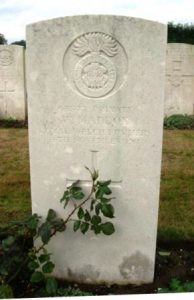
Walter James Meager, Rifleman, 6380, Rifle Brigade. Walter was born in Norwood, Surrey in 1884, the son of William Meager and Annie Meager (nee Baker). He enlisted into the Rifle Brigade as a young man and served for several years before leaving the army and becoming an Army Reservist. Walter returned to London where he found work as a carman. He married Frances Ellen Winnals on 15 September 1907 and the couple initially set up home at 28, Paxton Place, Hamilton Road, West Norwood. The couple then moved to Wales and resided at Llansantffraed for a while before leaving the country and emigrated to Australia in April 1912, settling at Inkermann Street, Granville, Sydney. Following the outbreak of war, Walter left Australia aboard the SS Militiades on 17 October 1914 and returned to England, where he re-joined his old regiment, the Rifle Brigade. Walter was then drafted to France on 26 January 1915, joining the 2nd Battalion, Rifle Brigade, which was in the Neuve Chapelle sector and was attached to 25 Brigade, 8th Division. The division saw its first major action at the Battle of Neuve Chapelle, which opened on 10 March 1915 and raged for three days, advancing through the village and capturing a number of prisoners in an action which saw CSM Harry Daniels of the 2nd Rifle Brigade gain the award of the Victoria Cross. The 8th Division remained in the area over the coming weeks, then on 9 May 1915 took part in another major action, the Battle of Aubers Ridge. The 2nd Rifle Brigade assembled together with the other attacking battalions of the division and charged across No Mans Land that morning to find the barbed wire uncut, due to inadequate artillery fire. Walter was killed in action during the ensuing fighting that day. The 31-year-old has no known grave and is commemorated on the Ploegsteert Memorial, Belgium.
William Francis Morris, Gunner, W/2198, Royal Field Artillery. William was born in 1898, the son of William Morris and Mary Ann Morris, of the Farmers Arms, Llansantffraed. He worked as a porter for the GWR at Resolven prior to the enlisting into the newly formed Welsh Divisional Royal Field Artillery soon after the outbreak of war. The 43rd (Welsh) Division had been formed as part of a planned Welsh Army Corps, but due to a lack of men, only the one division was formed. The units of the Division trained in North Wales before moving to Salisbury Plain in the summer of 1915, where the Division was renumbered to the 38th (Welsh) Division and William joined A Battery, 122nd Brigade, Royal Field Artillery within the Division. He embarked for France with the Battery on 24 December 1915 and the entire Division moved to the to the Nursery Sector near Fleurbaix for trench initiation alongside the Guards Division. The Division then held a sector of the line near Cuinchy before marching south to the Somme sector in June 1916 to take part in the assault on Mametz Wood. The first attack on the wood was launched on a two-battalion front on 7 July, but failed, and the Divisional Commander, Sir Ivor Philipps, was replaced before the Division attacked again on a two Brigade front on 10 July 1916. After two days of ferocious hand-to-hand fighting, the wood was cleared up to its northern edge, before the battered Division was relieved. It then took over a section of the front at Hébuterne before moving to the Ypres Salient and taking over the Canal Bank sector at Boesinghe. The infantry battalions of the Division then began carrying out the normal pattern of rotation in the trenches, four days in the front, four in support and four in reserve, whilst also working on trench improvement, digging new trenches, and carrying out regular patrols and trench raids. The Division was to take part in the opening assault of the Third Battle of Ypres, or Passchendaele, which was to be launched on 31 July 1917. During the build up to the offensive, the Divisional artillery was kept busy targeting key German positions facing the Division. William was gassed during the build up to the battle and was evacuated to the Casualty Clearing Station at Mendinghem where he died of pneumonia on 27 July 1917 because of his gassing. The 19-year-old is buried in Mendinghem Military Cemetery, Belgium.
Ernest O’Dell, Rifleman, 5095, Royal Irish Rifles. Ernest was the son of John William O’Dell and Eliza O’Dell (nee Weatherley), of 116, Welldon Crescent, Harrow. He came to work at Bwlch as a young man but following the outbreak of war enlisted at Marylebone into the Lancers. Ernest was then drafted to France on 30 June 1915 and was transferred to the 2nd Battalion, Royal Irish Rifles, which was attached to 7 Brigade, 3rd Division at Ypres. On 18 October the entire Brigade transferred to the 25th Division, which was at Le Touquet, having arrived in France the previous month, and the following week the 2nd Royal Irish Rifles transferred to 74 Brigade, in the same 25th Division. The Division wintered in the Le Touquet area and during March 1916 was posted to positions at La Targette in the Vimy Sector, north of Arras. By 10 May the 2nd Royal Irish Rifles was in positions at Zouave Valley and Cabaret Rouge, in Brigade Reserve. On 15 May the Germans shelled the area before firing two huge underground mines in front of the battalion. Men of the 11th Lancashire Fusiliers rushed forwards to consolidate the new craters and the 2nd Royal Irish Regiment helped consolidate the new positions over the following day. At dawn on 17 May 1916 the battalion was holding its new positions when the line was bombarded again by German artillery and was followed by an assault by German infantry. Heavy fighting raged throughout the day but due to heavy losses the Germans captured the craters. Ernest was killed in action during the fighting that day. The 27-year-old has no known grave and is commemorated on the Arras Memorial, France.
Roy James Oldcorn, Corporal, 8997, Royal Irish Rifles. Roy was the son of Arthur Egerton Oldcorn and Alice Oldcorn (nee Campbell), of Northop, Flintshire. He came to Bwlch to work as a Footman prior to the war. He enlisted into the 3rd Battalion, Royal Irish Rifles at Putney in 1915 and was posted to Dublin to join the battalion. Roy was involved with the Irish rebellion of Easter Monday 1916, but soon afterwards was drafted to France, joining the 8th Battalion, Royal Irish Rifles, which was attached to 107 Brigade, 36th Division. The Division was at Auchonvillers, on the Somme, during the Spring of 1916 and took part in the opening offensive of the Battle of the Somme on 1 July 1916. After further action during the latter stages of the Somme offensive, during the Battle of Le Transloy, the Division moved to the Arras sector and in April 1917 fought at the First Battle of the Scarpe. The Division then fought during the Third Battle of the Scarpe and remained in the Arras sector until July 1917 when the Division began moving to the Ypres Salient. The 8th Royal Irish Rifles were not at Ypres for long, as within weeks the battalion was posted to the Equancourt area where it merged with the 9th Royal Irish Rifles on 28 July 1917 to form the 8th/9th Battalion, Royal Irish Rifles in 107 Brigade, 36th (Ulster) Division. The battalion was stationed around Havrincourt Wood after being formed and remained in the area, rotating with the other battalions of the Division, in the front line over the coming months. On 20 November 1917 the Allies launched a massive offensive here, the Battle of Cambrai, using massed tanks in formation and broke the Hindenburg Line. The 8th/9th Royal Irish Rifles had been in reserve on the opening day and on 21 November moved forward into the Hindenburg Support Line where the battalion established itself in dugouts. On the following day the battalion was ordered to move forwards to meet a German counterattack at Kangaroo Alley, but no attack came, and the day passed quietly. On the following day, 23 November 1917, the battalion took part in an assault by the 36th Division upon the canal at Masnières. Roy was killed in action during the fighting that day. The 27-year-old has no known grave and is commemorated on the Cambrai Memorial, Louverval, France.
William John Powell, Guardsman, 3012, Welsh Guards. William was born in 1885, the son of William Powell and Jennet Powell (nee Williams), of Trosnant Cottage, Cantref. He worked as a waggoner at Lower Cantref Farm, Sennybridge prior to the war. William enlisted at Brecon into the Welsh Guards in the summer of 1915 and at some time in 1916 was drafted out to France to join the 1st Battalion, Welsh Guards. The Division had seen its first major action during the Battle of Loos, which began on 25 September 1915, remaining in the area during the coming months, where it also fought in the subsequent Action of Hohenzollern Redoubt. In July 1916 the Division moved to the Somme, where it fought at the Battle of Flers-Courcelette, and then at the Battle of Morval, capturing Lesboeufs Village. The division remained here for the winter, and in March 1917 took part in the advance caused by the German Retreat to the Hindenburg Line. William was wounded by a German gas bombardment around this time and was evacuated home to Britain for treatment at Queen’s Hospital in Birmingham. He died of his gas wounds there on 17 May 1917. The remains of the 31-year-old were brought home and he was buried in St. Mary’s Churchyard, Cantref on 15 May.
Thomas Sidney Richards, Gunner, 183826, Royal Garrison Artillery. Thomas was born in 1898, the son of John Richards and Sarah Richards (nee Evans), of Penbailey Farm, Llandetty. He worked for his parents on the farm prior to enlisting into the Royal Garrison Artillery at Brecon soon after the outbreak of war. Thomas was then drafted to France in September 1917 and was posted to the 237th Siege Battery, Royal Garrison Artillery. The battery had been raised on the Humber before embarking for France on 23 January 1917. The battery moved to Ypres where it remained for the remainder of the year, taking part in the Passchendaele offensive. The Battery moved slightly south during the winter of 1917-18, taking up positions near Neuve-Chapelle. Thomas was killed in action here by German counter-battery fire on 14 March 1918, when a shell exploded near his gun pit, killing him instantly. The 20-year-old was buried just behind the lines, in Le Touret Military Cemetery, Richebourg-L’avoue, France.
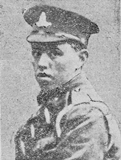
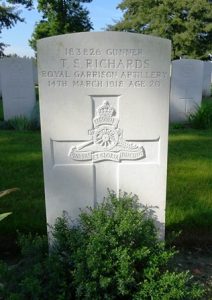
William Voss, Private, 36060, Welsh Regiment. William was born in 1880, the son of Walter Voss and Elizabeth Voss (nee Davies), of Penpound Cottage, Llandetty. He resided at Haverfordwest prior to the war and enlisted there into the 3rd Battalion, South Wales Borderers. William then left the army, joining the Army Reserve, but was mobilised soon after the outbreak of war and was posted to France on 5 May 1915, joining the 1st Battalion, Welsh Regiment, which was attached to 84 Brigade, 28th Division. The battalion was rebuilding its strength behind the lines at Herzeele, following heavy losses suffered during the Second Battle of Ypres, when William joined its ranks. The rebuilt battalion then marched back via Vlamertinghe to Ypres, taking over the trenches near Hooge on 22 May. The battalion was relieved two days later, moving back into support positions, but on 24 May the relieving battalion, the 11th Hussars, was attacked and lost ground, so the 1st Welsh had to rush forwards to their aid. Heavy fighting raged throughout the remainder of the day, whilst the line was restored, and on the following morning, 25 May 1915, the 1st Welsh launched a counterattack but suffered heavy losses before reforming on the north of the Menin Road near Witte Poort Farm, before renewing the attack upon German positions at Bellewaarde. William was wounded during the ensuing fighting, but soon re-joined the battalion, in time for its move south to join the Battle of Loos, which had opened on 25 September 1915. The 1st Welsh entered the fray on 29 September, taking up support positions at Vermelles, near where the 2nd Welsh had been almost wiped-out days earlier. Two days later the 1st Welsh moved into the front-line and prepared to launch an assault on Little Willie trench. The battalion attacked at dawn on 1 October and became caught up in desperate fighting over the coming days. William was killed in action there on 1 October 1915. The 35-year-old has no known grave and is commemorated on the Loos Memorial, France.
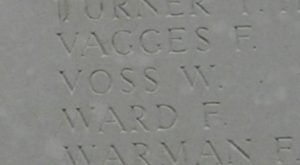
World War Two, 1939-1945
Henry Fenton Garnons Williams, Lieutenant-Colonel, 9670, Royal Welch Fusiliers. Henry was born on 17 February 1896, the son of Gerald Garnons Williams and Minnie Lilian Garnons Williams (nee Court), of St. John’s Mount, Brecon. He came from a military family, his father and two brothers both serving with the army during their lives and Henry was no exception, whilst several other relatives also fought, with some killed during the Great War. Henry was commissioned into the Royal Welsh Fusiliers as a young man and served in France with the 38th (Welsh) Division during the Great War, becoming a Staff Officer. He remained in the army after the war and married Katherine Paddison at Tiverton in 1925. By the time that World War Two broke out, Henry was serving as a Major with the Royal Welch Fusiliers. He was given command of the 1st Battalion, Royal Welch Fusiliers soon afterwards and took the battalion out to France, as part of the BEF. Henry died in France on 10 November 1939, prior to the German invasion of the Low Countries. The 43-year-old was buried in Douai Communal Cemetery, France.

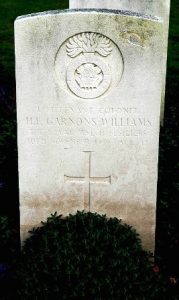
David Gereth Bowen-Jones, Ordinary Seaman, D/JX 160536, Royal Navy. David was born at Barry on 25 October 1922, the son of Reverend John Alfred Bowen-Jones, BA, and Lilian Gertrude Bowen-Jones (nee Snowden). The family later resided at Llansantffraed Rectory, Breconshire, after his father had become Curate there. David was educated at Christ College, before enlisting into the Royal Navy and after completing his training was posted aboard the Dido-class light cruiser, HMS Bonaventure. One of her first duties during the war was in Operation Fish, the evacuation of British wealth from the UK to Canada. She was then attached to the Mediterranean Fleet. On 31 March 1941 Bonaventure was sailing south of Crete when she was hit amidships by two torpedoes launched by the Italian submarine Ambra and sank with the loss of 139 of her 480 crew. David was 18 years old when he died that day. He has no known grave and is commemorated on the Plymouth Naval Memorial, Devon.
Ieuan Glynne Morgan, Sergeant, 1424536, Royal Air Force Volunteer Reserve. Ieuan was born in 1922, the son of James Edgar Morgan and Margaret Jane Morgan (nee Morris), of Pencelly Court Farm, Llanfeugan. His mother was from Llandetty. Ieuan enlisted into the Royal Air Force Volunteer Reserve early in the war and after completing his training as a Wireless Operator/ Air Gunner was posted to No 15 Operational Training Unit at RAF Harwell, for training aboard multi engine heavy bombers. On 13 February 1944 Ieuan took off from Harwell aboard a Vickers Wellington X, Serial LN658, on a night cross-country exercise. The aircrafts planned route was to fly from base to Taunton, then via Bideford to St. Mary’s, onto Skomer Island off the Pembrokeshire coast, back over Fishguard, the home via Worcester. At 22.10, the crew obtained a dix which showed they were more or less on track, however just ten minutes later, the aircraft was plotted as showing broad Identification Friend of Foe emissions, after which nothing further was heard. The Wellington was subsequently lost without trace, presumably having crashed in the Irish Sea, with the loss of all five of her crew. Ieuan was 22 years old when he was lost that night. He has no known grave and is commemorated on the Runnymede Memorial, Surrey.
John Thomas Reginald Morgan, Gunner, 968727, Royal Horse Artillery. John was born in 1917, the son of Evan Morgan and Sarah Gwen Morgan (nee Amos), of Maesporth, Scethrog. He enlisted into the Royal Artillery and was posted to 104 (The Essex Yeomanry) Regiment, Royal Horse Artillery. The regiment embarked for the Middle East in 1940 with the 1st Cavalry Division and served with the division in Palestine before transferring to Egypt in April 1941 to join the 2nd Armoured Division, as part of the Tobruk garrison. The regiment then took part in the Western Desert campaign, notably during the first Battle of El Alamein and then became caught up in the Siege of Tobruk, which lasted for seven and a half months. Following the breaking of the siege on 27 November, the regiment joined the 8th Army and after rebuilding joined the North African campaign. John was killed in North Africa on 12 June 1942. The 24-year-old has no known grave and is commemorated on the Alamein Memorial, Egypt.
Joseph Cromwell Smith, Leading Aircraftman, 1152497, Royal Air Force Volunteer Reserve. Joseph was born in 1914, the son of Joseph Smith and Margaret Ann Smith (nee Evans), of Cefn Coed. He married Betty Jones at Vaynor in 1937 and the couple settled at Llansantffraed. Joseph enlisted into the Royal Air Force Volunteer reserve soon after the outbreak of war and after being selected for training as an Air Gunner, was posted to 9 Air Gunners School at RAF Llandwrog, in Caernarvonshire, to complete his training. On 10 October 1941 Joseph took off from Llandwrog aboard an Armstrong Whitworth Whitley Mk I, Serial K7252 on a routine training flight over Caernarvon Bay. The aircraft was heading back to the airfield and beginning its approach when it collided with another Whitley and both aircraft crashed, killing 17 men. Joseph was 27 years old when he was killed in the tragic accident that day. His body was recovered from the wreckage and brought home for burial in Cefn Coed Cemetery.
Gilbert Williams, Stoker, D/KX 123621, Royal Navy. Gilbert was born on 25 September 1917, the son of Charles Williams and Ellen Williams (nee Meredith), of Talybont-on-Usk. He enlisted into the Royal Navy and was posted aboard the Dido-class light cruiser HMS Hermione. After her commissioning, Hermione joined the 15th Cruiser Squadron of the Home Fleet, in time to take part in the pursuit of the German battleship Bismarck and the heavy cruiser Prinz Eugen in May 1941. Following the sinking of Bismarck, Hermione took part in searches for its supply ships and German blockade runners before being deployed to the Mediterranean and joined Force H, at Gibraltar. Hermione rammed and sank an Italian submarine on 2 August 1941, whilst escorting a convoy. She continued in her convoy escort work over the coming months, seeing plenty of action, mainly as a result of German air attacks. Just after midnight on 16 June 1942, Hermione was patrolling north of Sollum when she was torpedoed by the lurking German submarine U-205 and sank with the loss of 88 lives. The survivors were picked up by the escorting destroyers and were landed at Alexandria. Gilbert was 25 years old when he died during the sinking of Hermione that morning. He has no known grave so is commemorated on the Plymouth Naval Memorial, Devon.